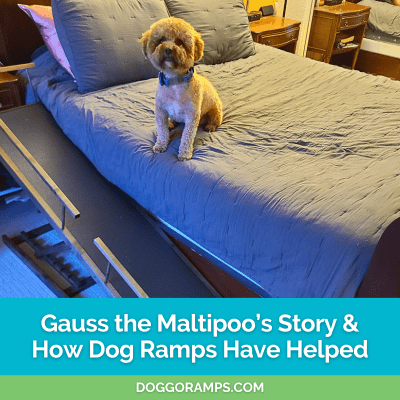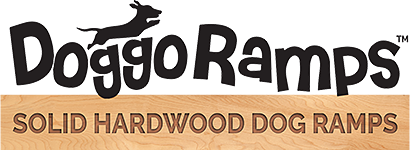Gauss the Maltipoo’s Journey with Luxating Patella and Hip Dysplasia

Meet Gauss - a 2-year-old Maltipoo living his best life in sunny California. As an energetic young pup, Gauss loves playing with his squeaker balls, participating in dog-friendly bubble eating sessions, chasing squirrels, frolicking at the beach, and so much more!
Despite his enthusiasm for play and the outdoors, Gauss hasn’t always been able to enjoy these activities. Within just the first year of his life, he was diagnosed with luxating patellas in both of his hind legs and right-sided hip dysplasia.
Thankfully, with exceptional care from his owners and veterinary team, Gauss has made incredible strides with his recovery and is able to enjoy his favorite games and places more than ever before!
In this post, we’ve teamed up with Gauss’ paw-rent to share the Maltipoo’s journey with his knee and hip conditions. By sharing Gauss’ story, we hope to raise awareness about luxating patella and hip dysplasia in small dogs and share resources, such as dog ramps, that have allowed Gauss to continue living a happy and fulfilling life.
What is Luxating Patella in Dogs?
Patellar Luxation is a very common knee condition in small dog breeds, such as Yorkshire Terriers, Toy Poodles, and Chihuahuas. According to the American College of Veterinary Surgeons, about 7% of puppies are diagnosed with it. While it can occur in dogs of any size, smaller dogs tend to have a higher genetic predisposition.
When a dog has a luxating patella, their kneecap (patella) will repeatedly pop out of place. This usually happens because there’s some sort of abnormality with the groove their kneecap should sit in or a misalignment with the limb.

Dogs with this condition will often skip or kick their legs while walking in order to try to get their kneecap back into place. Patellar Luxation can impact one or both of a dog’s hind legs.
There are also 4 grades of patellar luxation - the higher the grade, the more severe the condition - and often, Grade II-IV luxations require surgical correction.
If untreated, a dog’s knee cap may begin to slide out of place more frequently, which can lead to further joint damage, other knee injuries, and arthritis.
Gauss' Journey with Luxating Patella and Hip Dysplasia
Gauss started showing signs of having trouble with his back legs when he was still a puppy.
Before he was even 6 months old, Gauss' owners decided to consult a veterinary behaviorist as the Maltipoo was having a difficult time acclimating to wearing a harness and was showing leash reactivity when around other dogs. With his persistent sensitivity, his humans started to feel that a bigger issue may be at play, such as chronic anxiety or pain.
The vet behaviorist quickly noticed that Gauss was walking with an unusual gait and suspected hip dysplasia.
During a vet visit one week later, x-rays revealed a knee issue and hinted at a potential hip issue too. The specialty surgeon was hesitant to diagnose a small breed with hip dysplasia, but knee surgery was recommended for Gauss around the age of 2. In the meantime, Gauss was prescribed medication for managing pain and inflammation.
Gauss at his initial surgery consultation when he was just 9 months old.
Unfortunately, Gauss would require surgical intervention sooner.
Just seven months later, Gauss experienced a moment of severe distress. He suddenly emitted a piercing scream and his owners found him lying motionless. Once he stood up, he could only walk on three legs and refused any comfort.
Now living in California, his paw-rents quickly took him for an emergency examination and further investigation confirmed that he had bilateral luxating patellas and right-sided hip dysplasia. His right knee had a Grade III Luxation.
Immediate surgery, officially known as a medial patella luxation correction, was recommended for his right knee, and the SAGE Veterinary Hospital swiftly provided exceptional care - impressing Gauss’ owners with their efficiency and genuine concern for their pup’s well-being.

Luxating Patella Surgery Recovery
Surgery recovery wasn’t easy for Gauss.
As an energetic and young Maltipoo, he wanted nothing more than to run, jump, and play. His owners had to remain extremely vigilant during the 10-week period of activity restriction following surgery, which was made up of 6 weeks of strict crate rest and 4 weeks of rehabilitation.

Despite being crate trained, Gauss also experienced greater separation anxiety after his surgery and had to be hand fed his meals due to the constraints of wearing a cone.
Fortunately, Gauss' anxiety improved overtime, and due to training before surgery, he was able to continue safely accessing and snuggling up with his owners in bed with the help of DoggoRamps Small Bed Ramp.

Now, less than 6 months after his knee surgery, Gauss is thriving and enjoying an active lifestyle. Before, Gauss would have to take frequent breaks during his walks in order to kick his knee back into place. Now, he is able to take hour-long walks without any pauses.
His passion for fetch has only grown, and his owners are overjoyed that he is able to take part in his favorite activities again as they wait for him to qualify for further surgery on his right hip and left knee.
Caring for a Maltipoo with Patellar Luxation and Hip Dysplasia
Since Gauss will still require further surgery, his paw-rents take great care in making sure that he avoids over-exerting himself. This could lead to flare-ups with his right hip and left knee.
The Maltipoo’s vet also emphasized the importance of preventing him from jumping off furniture to slow down arthritis progression, so he continues to exclusively use his DoggoRamp to get on and off one of his favorite spots - his owners’ bed.
Gauss’ owner shared that his bed ramp has been instrumental in his recovery and ongoing well-being.

When first introduced to his ramp, Gauss learned how to use it in a matter of hours. His paw-rents quickly noticed a significant boost in his confidence due to his newfound independence. Gauss has also discovered his new favorite morning routine which involves stretching while exiting his WLO dog house and walking up his ramp to shower his owners with good morning kisses in bed.
And of course, Gauss has learned that he can play fetch down his ramp too!
Beyond jumping, the Maltipoo’s owners have also made sure that Gauss avoids skidding and slipping as much as possible on tile and wood flooring as this can cause his left patella to pop out and lead to significant pain. All play sessions, including ball games, take place on a non-skid surface to help keep his knee safe. Medication continues to help reduce discomfort and keep Gauss at ease.
Outside of home, Gauss takes part in regular laser therapy, hydrotherapy, and physical therapy sessions at the SAGE Veterinary Center in California and is consistently motivated by the clinic’s high-value reward - home-cooked chicken!

Gauss' owners are committed to helping their pup live life to the fullest and have dedicated an Instagram account to sharing all the resources that help Gauss thrive and enjoy his best life! To learn even more about Gauss’ journey and adventures, make sure to follow him on Instagram at @gaussthedood!
The DoggoRamps Team would also like to extend a huge thank you to Gauss’ paw-rents for giving us the opportunity to share his story.
To learn more about our indoor dog ramps too, check out:
- The DoggoRamps Couch Ramp (supports dogs up to 150 lbs.)
- The DoggoRamps Small Bed Ramp (supports dogs up to 50 lbs.)
- The DoggoRamps Large Bed Ramp (supports dogs up to 200 lbs.)
- The DoggoRamps Step-Ramp (supports dogs up to 200 lbs.)
Leave a comment
Comments will be approved before showing up.




